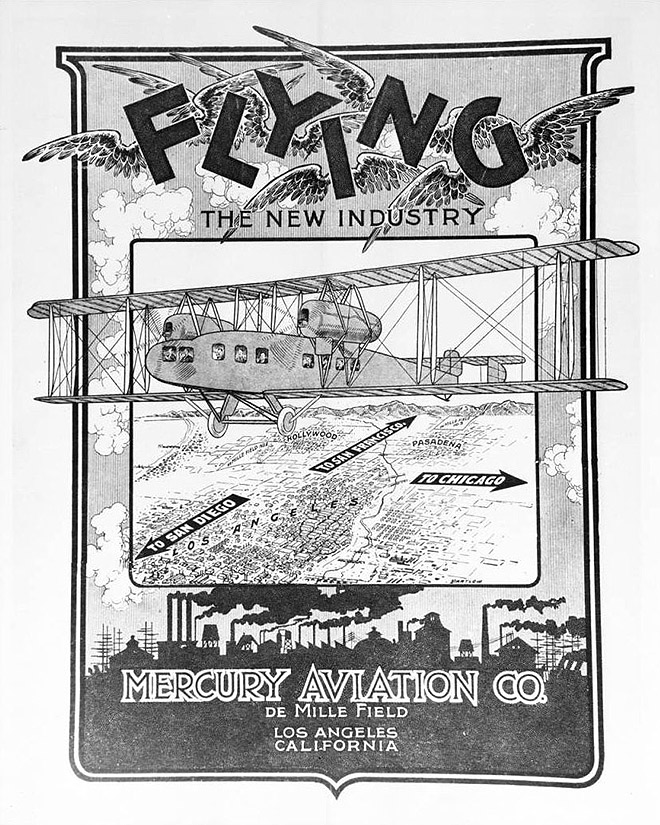In my book I gave a few facts about the earliest airline service, a topic that always seems to start arguments. There are multiple claims regarding which carrier operated the world’s first airline service, and the correct answer depends on how you define the terms. The St. Petersburg-Tampa Airboat Line started scheduled service in 1913, unquestionably before anybody else, but their operations weren’t really what we would now think of as an airline. The flights took 23 minutes to travel 23 miles, and attained the awesome height of five feet above the water while carrying the pilot and one passenger. The flights were subsidized by the city of St. Petersburg for five weeks, and when that subsidy ran out operations ceased immediately. Milestone that it was, it was still a publicity stunt. A similar service ran in Yorkshire between Bradford and Leeds in Yorkshire in 1914 – it was subsidized for two days, then promptly folded.
Red Arrow Flying Service started passenger flights from Fort Lauderdale, Florida to the Bahamas in 1917, but like the air taxi service between Tampa and Sarasota they only carried a single passenger. They changed the name to Chalk’s International Airline in 1919 and were first to carry multiple passengers on scheduled flights, still flying to Bimini in the Bahamas. That was their only destination for seventy years – the airline remained in business until 2007.
(I have been unable to figure out what type of aircraft were first used by Chalk’s. An article in Smithsonian Magazine incorrectly states that the airline operated their first service with a Stinson Voyager seaplane, but this can’t be true – the Stinson company didn’t start making aircraft until 1925, and their first model was the Detroiter. Chalk’s did use Voyagers later, but not until the late 1940’s. If anyone can enlighten me regarding the earliest aircraft used by Chalk’s that carried multiple passengers, I’d be obliged.)
Chalk’s never served meals during their entire existence, nor did any of the airlines that started in Europe between 1917 and 1919. Most used open-cockpit aircraft, which meant that no food could possibly be served, and the first closed-cabin aircraft from Junkers seated only three people plus the pilot. It wasn’t until 1920, when KLM, Handley-Page Transport and Air Union started service using modified First World War bombers, that passengers were inside a cabin and inflight beverage service became possible.
There was one interesting might-have-been. The famed Hollywood director Cecil B. DeMille was an aviation enthusiast who built an airport at the corner of Wilshire and Fairfax, which he modestly named DeMille Field #1. In 1918 he started an airline called Mercury Air Service, and from their 1919 brochure you can see that he had big dreams: DeMille wanted to operate regular passenger flights, but at the time only two-seat Curtiss Jenny aircraft were available, so Mercury operated charter service and sightseeing trips for two years. Air ace Eddie Rickenbacker delivered a closed-cabin Junkers in 1920, and soon thereafter Mercury Aviation offered scheduled flights to Bakersfield, Fresno, San Francisco, San Diego, and Catalina Island. This made them the world’s first airline regularly serving multiple destinations. Over 25,000 passengers flew the carrier, but it was never robustly profitable and was shut down in 1922. I haven’t been able to find out what food and drink was served aboard their aircraft, but with a showman like DeMille in charge, I can only assume it was the best that could be arranged.
DeMille wanted to operate regular passenger flights, but at the time only two-seat Curtiss Jenny aircraft were available, so Mercury operated charter service and sightseeing trips for two years. Air ace Eddie Rickenbacker delivered a closed-cabin Junkers in 1920, and soon thereafter Mercury Aviation offered scheduled flights to Bakersfield, Fresno, San Francisco, San Diego, and Catalina Island. This made them the world’s first airline regularly serving multiple destinations. Over 25,000 passengers flew the carrier, but it was never robustly profitable and was shut down in 1922. I haven’t been able to find out what food and drink was served aboard their aircraft, but with a showman like DeMille in charge, I can only assume it was the best that could be arranged.
